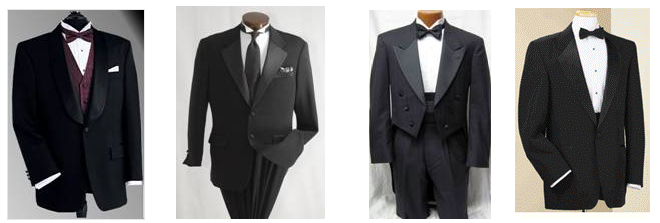 Most men have the opportunity, at one time or another, to attend a formal affair. Proms, weddings, and other formal or “black tie” events require us to up the ante and look our best by wearing the suit of all suits – the “tuxedo”.
Most men have the opportunity, at one time or another, to attend a formal affair. Proms, weddings, and other formal or “black tie” events require us to up the ante and look our best by wearing the suit of all suits – the “tuxedo”.
Although the tux has been subjected to fashion trends throughout the years, it has remained, without question, the most elegant and timeless suit a man can wear, which is one reason we need to wear them properly and proudly.
Today’s designers have broadened the spectrum by offering styles, fabrics, and colors of tuxedos that assure there’s something for everyone. Yet, as wonderful as it is to have so many options, the countless choices have a way of confusing us when it comes to choosing the best and most appropriate tuxedo for the occasion. So, to make life a little easier, and to keep you looking as dapper as every alpha male should look, let’s take a look at the world of tuxedos and break it down.
A tuxedo is both a formal and semi-formal suit that is worn with a cravat of some type (bow tie, Euro-tie, ascot, or four-in-hand long tie), and a vest or cummerbund. Most commonly worn in black, tuxedo colors include white, brown, dark blue, ivory, charcoal grey, and light grey. Other colors are available, but are rarely worn today. Occasionally, adventurous prom goers, grooms, and groomsmen wear pastel colors, but it’s unusual to see anymore – unlike yesteryear when pastels were the rage. Color tip: wear charcoal or dark grey, with or without stripes, during the day, and black only at night.
There are five key things to factor when wearing a tuxedo, whether you rent or buy one.
- The type of event: wedding, prom, dinner party, etc. and its dress code.
- The season: winter, spring, etc.
- The time: day or night.
- Body type: like other suits, styles look best when matched with body type.
- Partner Coordination: be sure to find out what color your lady is wearing if she’s attending, so you can be color compatible. Trust me… this one’s important!
Once you’ve got that down, it’s time to go get a tux!
Tuxedo Fabric
Traditionally, tuxedos have been made of fine wool. The majority still are woolen, but synthetic tuxes are also very popular because of their conveniences: wrinkle resistance, light weight fabric, and price tag. Basically, synthetic tuxedo fabrics are polyester-type fabrics. Wool tuxedos vary in quality and price, due to the type wool they’re made from. It’s up to personal preference, but issues like rent or purchase, frequency of use, type of events worn to, and a guy’s budget should be the determining factors.
Fortunately, tuxedo fabrics come in various weights, in order to keep us comfortable no matter the time of year… an option our grandfathers didn’t have. For those looking to purchase and own only one tux, a medium weight fabric is a good choice, since it can be worn year round.
In addition to the primary fabric, tuxedos normally have satin (made from silk or a synthetic material), or grosgrain (a tightly woven fabric with heavy crosswise ribbing normally made of silk) on lapels and button facings. However, there are also “self-facing” tuxedos, which have no additional fabric on the lapels and button facings; resulting in a less dressy tux made only of the primary fabric.
Style
There are three basic tuxedo styles that should be factored into the type event you’re attending, but more importantly, tuxedo choices should be based on body type. Apply the same rules to tux jackets that you do to suit jackets when choosing your appropriate, most flattering style. Remember, body type always come first when choosing almost any clothing. You can wear a top designer tux, but if it doesn’t compliment your stature, its magnificence is lost.
Traditional Jackets Styles
- Single Breasted: This jacket has one row of buttons with a narrow overlap of fabric. This style is more informal than other styles, yet is acceptable for even the most formal affairs. This jacket looks great on everyone, especially short men regardless of weight. Styles come with two or three buttons, which should be chosen based on body type: short/2 – tall/3.
- Double Breasted: This style jacket has a very wide overlap of fabric, with two parallel rows of buttons. This type jacket is considered very formal, and should be worn to very formal events. This style looks amazing on tall, thin guys; however, shorter men can wear it, also. Heavy men should avoid this style because it will emphasize the waistline. Very thin men should consider opting for large shoulder pads, which will broaden the shoulders more than normal shoulder pads. Certain brands offer this feature, and it can also be added to custom-made tuxes. You may want to avoid the double breasted style if your shoulders are extremely broad because it will accentuate them. Again, if you can wear a double breast suit jacket well, it should work with a tux.
- Full Dress Tails: This classic is often called a tailcoat, due to its long tails in the back. Although it has buttons, there are no functioning buttons in the front to fasten the jacket closed. Don’t even think about wearing this during the day! It’s for formal eveningwear after 6 PM. Tall, fit men definitely have an advantage with this style. The short, cropped jacket exposes the legs, and although this style should be avoided if you’re looking to minimize your height, it’s flattering, otherwise. The tail length should basically fall to just behind the knees, which is one reason short men should avoid this style if possible, since the tails draws the eye downward. At the same time, the cropped jacket is advantageous to short guys because it draws the eye upward. It really boils down to your preference. It’s not the best style for heavyset men because the cropped jacket will accentuate the waistline. The tailcoat tux is the perfect tuxedo for a top hat, so if you’re into hats, now’s the time!
Lapels
There are three styles to choose from: notch, peak, and shawl. The alternative Mandarin collar is also an option, but not commonly worn.
- The notch lapel is the same lapel found on most suits. It has a cutout between the collar and the lapel.
- The peak lapel, a dressier lapel than the notch, is peaked upward and outward.
- The shawl lapel is a continuation of the collar, and has no distinguishing cutouts or peaks. It’s also known as the shawl collar.
Vents
There are three options: center, side, and non-vented.
- The center vent is a single slit in the back of the jacket.
- The side or double vent has two slits or openings in the back.
- Non-vented, or ventless, has no openings in the back of the jacket. This style is most restrictive when sitting.
The choice is yours, but keep in mind double vents offer the most room and comfort when sitting. This style is the best choice for anyone looking for more room and less restriction.
Buttons
Most tuxedos have fabric-covered buttons that are covered with the same accenting fabric found on the jacket lapels, etc.
Pockets
There are three styles: double besom, hacking, and convertible flap. Pocket style is based on personal preference.
- Double besom pockets are sewn into the jacket, instead of being sewn onto it. They are flapless and have a welted slit opening made of satin or grosgrain. This style is most commonly found on tuxedo jackets, and is considered the most formal of pockets.
- Hacking pockets, derived from English riding jackets, are designed like the double besom, but are cut on a diagonal and have a flap.
- Convertible flaps, also known as convertible besom flaps, are a besom pocket with a flap. The convertible aspect refers to the option of wearing the flap outside the pocket or tucked in.
Pants
Traditional styles include flat front or pleated. Fortunately, the knicker trend is over.
- Flat-front pants are most flattering, but if you need more room for comfort or dancing, pleated pants are fine. The pant stripe is optional; however most tuxedo pants have this distinctive detail, which matches the accent fabric on the jacket. There’s no need for belt loops, since belts are not worn with tuxedos. The waistline is covered by either a cummerbund or vest. Formal pants should not have cuffs, especially flat-fronts. However, I have seen the occasional tuxedo pant that has cuffs and belt loops – neither of which are preferred.
Vests and cummerbund
Either is acceptable, but cummerbunds are more formal than vests. Vests and cummerbunds should never be worn together. They can be the same color of the tuxedo, or just about any color you’d like. Typically, their color matches the color of the woman’s dress when wearing it to a prom or by a groomsman. Vests can be worn with a bow tie, Euro tie, ascot, or four-in-hand long tie, which has become popular among younger tuxedo wearers – much to the disappointment of the traditionalists. Regardless of the tie you wear, make sure it matches the color of the vest or cummerbund. Cummerbunds look best with bow ties, and should never be worn with long ties. When wearing a cummerbund, be sure to wear it with the pleats facing upward.
Normally, we have no choice to the style and color of our tuxedo if it’s being worn in a wedding, so don’t stress if it’s not your tux of choice. However, when renting or buying for personal use, the choices are yours to make. When in doubt, consult a tuxedo expert, who can be found at the tuxedo shop or online. Save yourself a lot of trouble by being professionally measured, which is recommended with online rentals and sales, also. As tempting as it is to use your suit measurements, don’t do it – get professionally measured, since above all else, the tuxedo must fit your properly!
Watch for my complementary article on Tuxedo Etiquette that will be posted soon. Spring is around the corner, and with it comes proms and weddings galore. What better time than now to polish your tuxedo know how!
by Aaron Marino













